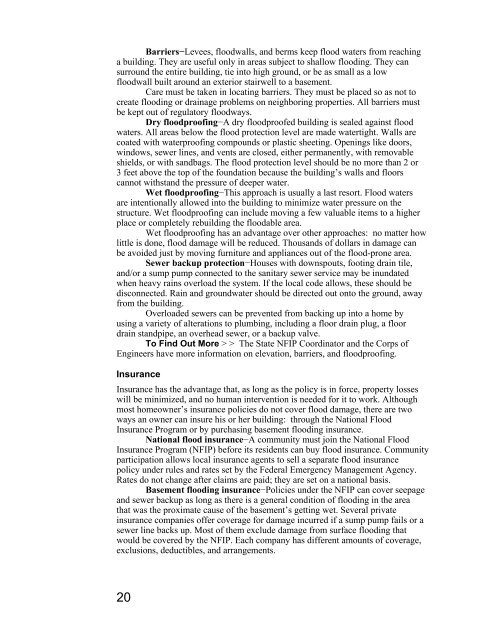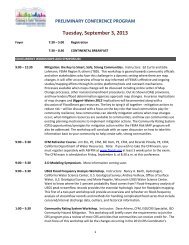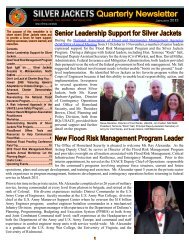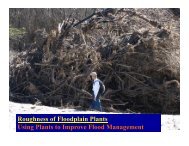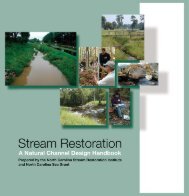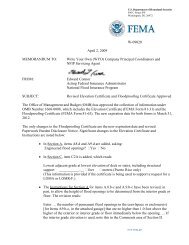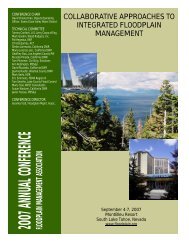Using Multi-Objective Management to Reduce Flood Losses in Your
Using Multi-Objective Management to Reduce Flood Losses in Your
Using Multi-Objective Management to Reduce Flood Losses in Your
Create successful ePaper yourself
Turn your PDF publications into a flip-book with our unique Google optimized e-Paper software.
Barriers−Levees, floodwalls, and berms keep flood waters from reach<strong>in</strong>g<br />
a build<strong>in</strong>g. They are useful only <strong>in</strong> areas subject <strong>to</strong> shallow flood<strong>in</strong>g. They can<br />
surround the entire build<strong>in</strong>g, tie <strong>in</strong><strong>to</strong> high ground, or be as small as a low<br />
floodwall built around an exterior stairwell <strong>to</strong> a basement.<br />
Care must be taken <strong>in</strong> locat<strong>in</strong>g barriers. They must be placed so as not <strong>to</strong><br />
create flood<strong>in</strong>g or dra<strong>in</strong>age problems on neighbor<strong>in</strong>g properties. All barriers must<br />
be kept out of regula<strong>to</strong>ry floodways.<br />
Dry floodproof<strong>in</strong>g−A dry floodproofed build<strong>in</strong>g is sealed aga<strong>in</strong>st flood<br />
waters. All areas below the flood protection level are made watertight. Walls are<br />
coated with waterproof<strong>in</strong>g compounds or plastic sheet<strong>in</strong>g. Open<strong>in</strong>gs like doors,<br />
w<strong>in</strong>dows, sewer l<strong>in</strong>es, and vents are closed, either permanently, with removable<br />
shields, or with sandbags. The flood protection level should be no more than 2 or<br />
3 feet above the <strong>to</strong>p of the foundation because the build<strong>in</strong>g’s walls and floors<br />
cannot withstand the pressure of deeper water.<br />
Wet floodproof<strong>in</strong>g−This approach is usually a last resort. <strong>Flood</strong> waters<br />
are <strong>in</strong>tentionally allowed <strong>in</strong><strong>to</strong> the build<strong>in</strong>g <strong>to</strong> m<strong>in</strong>imize water pressure on the<br />
structure. Wet floodproof<strong>in</strong>g can <strong>in</strong>clude mov<strong>in</strong>g a few valuable items <strong>to</strong> a higher<br />
place or completely rebuild<strong>in</strong>g the floodable area.<br />
Wet floodproof<strong>in</strong>g has an advantage over other approaches: no matter how<br />
little is done, flood damage will be reduced. Thousands of dollars <strong>in</strong> damage can<br />
be avoided just by mov<strong>in</strong>g furniture and appliances out of the flood-prone area.<br />
Sewer backup protection−Houses with downspouts, foot<strong>in</strong>g dra<strong>in</strong> tile,<br />
and/or a sump pump connected <strong>to</strong> the sanitary sewer service may be <strong>in</strong>undated<br />
when heavy ra<strong>in</strong>s overload the system. If the local code allows, these should be<br />
disconnected. Ra<strong>in</strong> and groundwater should be directed out on<strong>to</strong> the ground, away<br />
from the build<strong>in</strong>g.<br />
Overloaded sewers can be prevented from back<strong>in</strong>g up <strong>in</strong><strong>to</strong> a home by<br />
us<strong>in</strong>g a variety of alterations <strong>to</strong> plumb<strong>in</strong>g, <strong>in</strong>clud<strong>in</strong>g a floor dra<strong>in</strong> plug, a floor<br />
dra<strong>in</strong> standpipe, an overhead sewer, or a backup valve.<br />
To F<strong>in</strong>d Out More > > The State NFIP Coord<strong>in</strong>a<strong>to</strong>r and the Corps of<br />
Eng<strong>in</strong>eers have more <strong>in</strong>formation on elevation, barriers, and floodproof<strong>in</strong>g.<br />
Insurance<br />
Insurance has the advantage that, as long as the policy is <strong>in</strong> force, property losses<br />
will be m<strong>in</strong>imized, and no human <strong>in</strong>tervention is needed for it <strong>to</strong> work. Although<br />
most homeowner’s <strong>in</strong>surance policies do not cover flood damage, there are two<br />
ways an owner can <strong>in</strong>sure his or her build<strong>in</strong>g: through the National <strong>Flood</strong><br />
Insurance Program or by purchas<strong>in</strong>g basement flood<strong>in</strong>g <strong>in</strong>surance.<br />
National flood <strong>in</strong>surance−A community must jo<strong>in</strong> the National <strong>Flood</strong><br />
Insurance Program (NFIP) before its residents can buy flood <strong>in</strong>surance. Community<br />
participation allows local <strong>in</strong>surance agents <strong>to</strong> sell a separate flood <strong>in</strong>surance<br />
policy under rules and rates set by the Federal Emergency <strong>Management</strong> Agency.<br />
Rates do not change after claims are paid; they are set on a national basis.<br />
Basement flood<strong>in</strong>g <strong>in</strong>surance−Policies under the NFIP can cover seepage<br />
and sewer backup as long as there is a general condition of flood<strong>in</strong>g <strong>in</strong> the area<br />
that was the proximate cause of the basement’s gett<strong>in</strong>g wet. Several private<br />
<strong>in</strong>surance companies offer coverage for damage <strong>in</strong>curred if a sump pump fails or a<br />
sewer l<strong>in</strong>e backs up. Most of them exclude damage from surface flood<strong>in</strong>g that<br />
would be covered by the NFIP. Each company has different amounts of coverage,<br />
exclusions, deductibles, and arrangements.<br />
20


